Official Water Works Game Rules
The following page is a copy of the rules as printed in
the Water Works Rule Book.
OBJECT
Top of page
To be the first player to build a complete, leak free,
pipeline from your valve card to your spout card.
The number of pipe cards you need to
place in between them (but not including them) varies by the number of
players:
2 players 15 pipe cards minimum
3 players 12 pipe cards
minimum
4 players 10 pipe cards minimum.
EQUIPMENT
Top of page
Deck of 88 cards and 8 plumbers (cardboard disks).
The 88 cards consist of spout and valve cards (enough for four players), plus many different kinds of pipe section cards.
Copper colored pipes can never leak. Iron pipes can be made to leak, and some iron pipes are already leaky.
SETUP
Top of page
Remove all spout and valve cards from the deck. Give each player one of each.
Place out of play any unused spout and valve cards.
Give each
player two Plumbers (cardboard disks).

Each player places his or
her valve cards face up, in a vertical position, and to
his or her right on the playing surface. You will all
build right to left.
Set aside your spout card for now, you only play it
when you are ready to win the game.
Set aside your Plumbers for use during the game.
Shuffle the deck and deal 5 cards to each player, face down. Place the remainder
in a face down stack in the center of the playing surface. This is the "draw"
pile.
PLAY
Top of page
Select a player who will play first. Play passes to the
left. Always begin your turn by drawing the top card
from the draw pile.
Now you may make any ONE of the following plays, using
the six cards in hand.
1. Place a "good" pipe card (which means a copper pipe or non"leaky" iron pipe) next to your
valve card, to begin your pipeline.
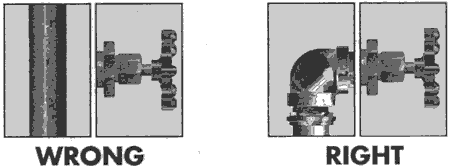 .
.
2. Place a "leaky" pipe card next to the valve card of an other player.

3. Discard a card face up to the left of the draw pile (forming the start of the "discard" pile).
You must end your turn with exactly five cards in hand.
The player to your left now goes. As play proceeds, other kinds of card play are possible (see
"REPAIRS" and "LEAKS") but only one card may ever be played by a player per
turn.
RULES FOR PLACING PIPE CARDS
Top of page
1. All cards must be placed VERTICALLY and only so that
the pipes properly join together.

2. Cards may be turned around end-for-end as long as
they remain vertical. Once placed a card may not be moved.
3. No card may be placed in such a way that it completely blocks a pipeline from
continuing.

4. You can't build your pipeline beyond the edge of the
table you're playing on nor over an opponent's
pipeline. So be sure to play on a big enough table and
allow plenty of room between valves when you start to
play.
LEAKS
Top of page
A player may try to delay an opponent's progress by
playing a leaky pipe card on their pipeline. A "leaky"
pipe card can only be played on top of, or adjacent to,
the last card in an opponent's pipeline. If played on
top of the last pipe, it can only be played on exactly
the same-shaped pipe section.
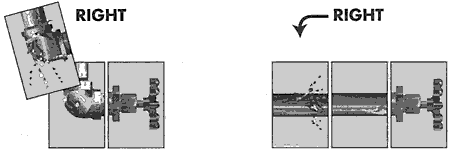
Remember: You can't make copper pipes leak, only iron
pipes. If placed after the last pipe card, the pipe can
be of any shape, provided it continues the pipeline
according to the rules above.
No more than one "leaky" pipe or cap can be part of a
player's pipeline at any time.
Once a leaky pipe has been repaired, it may not be made
to leak again. Also, you may not play a good pipe on an
opponent's pipeline.
REPAIRS
Top of page
A leaky pipe may be repaired in either of two
ways:
1. On your turn, you may cover the leaky pipe card with
a good pipe card of the same shape.
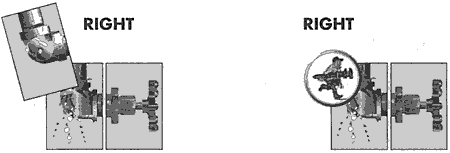
2. You may place one of your Plumbers on the leaky pipe card to repair it. Once played, a Plumber may not move.
If you place a Plumber on your turn, you may not
place a card as well. Instead, you must discard a card
to the discard pile.
Until a leak is repaired, you may not add a good card
to the end of your pipeline.
Exception: You may play a good cap on one end of a
"leaky" T pipe in your pipeline before the pipe itself
is repaired.
"T's" and "CAPS"
Top of page
A "T" pipe makes it possible for water to flow in two
directions in a pipeline.
A player must cap one of these directions before he can
win the game as water must flow only from the valve to
the spout (with no leaks or any "second" open sections
of pipeline).
It is best to hold onto a good T card to place on a
leaky T played on your pipeline by an opponent. (Of
course, it also makes sense to place a leaky T on an
opponent when he opportunity is right.)
A "CAP" card has 4 caps on it. Some may be copper, some
iron and some may be leaky.
It is best to "cap" one of the open ends of a "T" on
your pipeline as soon as possible, otherwise an
opponent could "cap" your longer section of
pipe and ruin many turns worth of your careful pipe
building, as in this example:
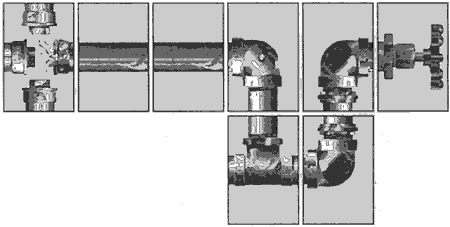
When placing a cap card, those caps not connecting to a
pipe are simply ignored as if they didn't
exist.

Only the cap connected to a pipe matters. If this one
is leaky, you have only to repair it, not the other
caps on the card. A cap card may not be counted as part
of the total pipeline for purposes of winning the
game.
WINNING
Top of page
Play continues, turn by turn, until one player succeeds
in placing at least the required number of pipe cards
from his or her valve to permit him or her to win by
placing the spout. Sometimes twists and turns in a
pipeline will require more than the minimum number of
pipe cards to be placed before a player can win. As
soon as you have played the required number of cards in
one continuous line, you may add your spout card to the
end of this line on the same turn and win the
game!
How to add the spout:
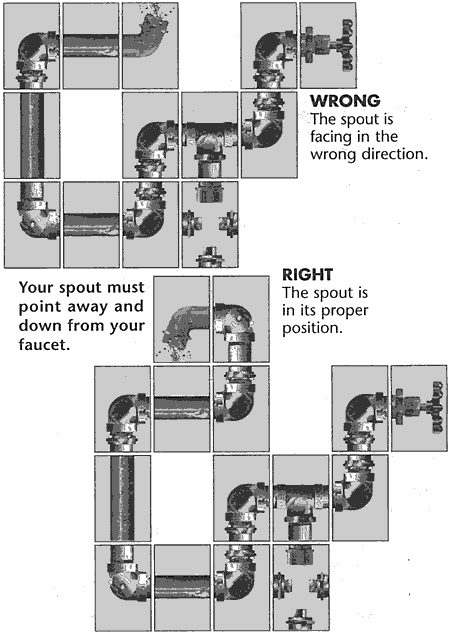
WATERWORKS TM is a trademark of Hasbro, Inc. All Rights Reserved.
Used
under authorization. c 1972, 1996 Hasbro, Inc., Pawtucket, RI 02862.
My Monopoly Site
Monopoly®, the distinctive design of the
game board, the four corner squares, as well as each of the
distinctive elements of the board and the playing pieces
are trademarks of Hasbro, Inc. for its real estate trading
game and game equipment. ©1935, 1936, 1947, 1951, 1952,
1954, 1961, 1973, 1984, 1994, 1995, 1996, 1997, 1998, 1999, 2000, 2001, 2002,
2003, 2004, 2005, 2006 Hasbro, Inc.

 .
.






